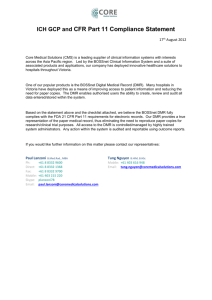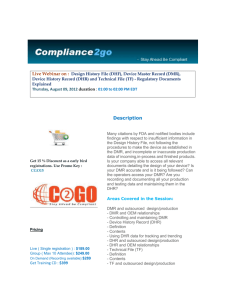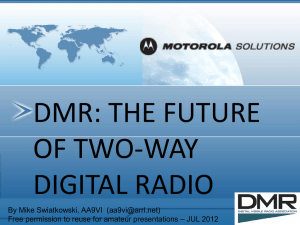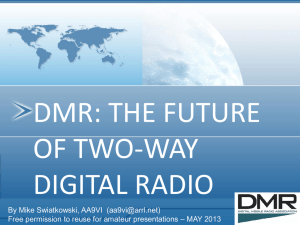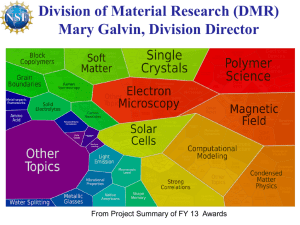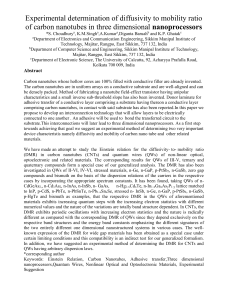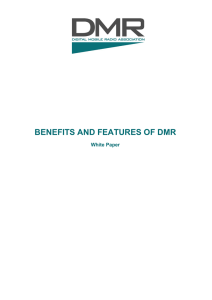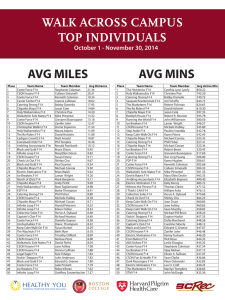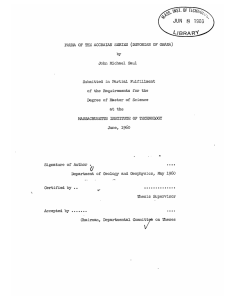Intro to DMR
advertisement
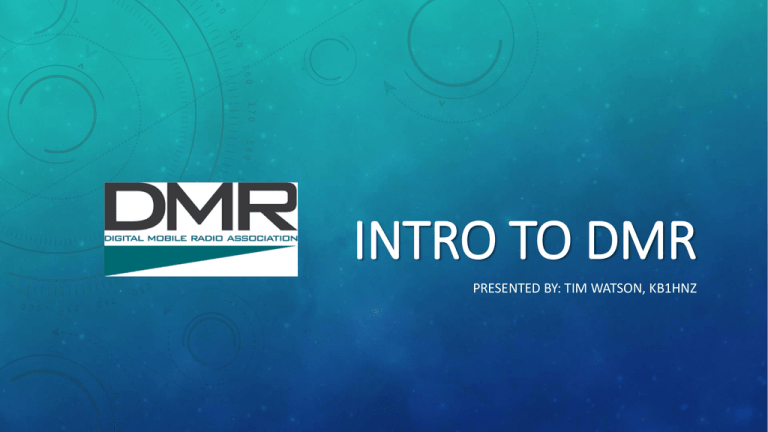
INTRO TO DMR PRESENTED BY: TIM WATSON, KB1HNZ DMR, or Digital Mobile Radio, is an Open Standard defined by the European Telecommunications Standards Institute (ETSI), and used in commercial and amateur products around the world. Designed to operate within the existing 12.5 kHz channel spacing used in licensed land mobile frequency bands globally AND to meet future regulatory requirements for 6.25 kHz channel equivalence. Affordable digital systems with low complexity. DMR products are sold in all regions of the world. The DMR protocol covers: Unlicensed (Tier I) Licensed Conventional (Tier II) Licensed Trunked (Tier II) DMR, similar to P25 Phase II, both use two-slot TDMA (Time Division Multiple Access) in a 12.5 kHz channel, while NXDN uses discreet 6.25 kHz channels using frequency division. The primary goal of the DMR standard is to specify a digital system with low complexity, low cost, and interoperability across brands, so radio communications end users are not locked into a proprietary solution. This being said, there are brands which have not adhered to this open standard and have introduced proprietary features that make their products incompatible with some networks. Open Interfaces, Open Standards, and an Open Philosophy. In 2005, a Memorandum of Understanding was formed with potential DMR suppliers to establish common standards and interoperability. Although the standard does not specify it, members agreed to use the half-rate DVSI Advanced Multi-Band Excitation (AMBE) vocoder to ensure interoperability. In 2009, members established the DMR Association to further advance the standard and to maintain interoperability. Formal testing has been taking place since 2010. DMR and Ham Radio All-digital network of over 400 repeaters in 37 countries. More than 10,000 registered users Repeaters are connected ALL the time. Excellent voice quality and extended battery life. Less than 1/3 the channel bandwidth of analog FM with twice as many voice channels! Reliable and scalable choice in connectivity Source: DMR-MARC Newsletter - May, 2014 Two-Slot TDMA DMR Tier II / Tier II occupies a 12.5 kHz bandwidth with tow channels sharing using TimeDivision Multiple Access (TDMA). This results in spectrum efficiency of 6.25 kHz per channel. Comparing spectrum efficiency of DMR to a wideband FM modulated signal, DMR only uses 25% of the bandwidth per talk channel. Each channel can carry either voice or data, depending on the system design. The two time slots are called Time Slot 1 (TS1) and Time Slot 2 (TS2). Left: fc -12.5 fc fc+12.5 Wide-band FM 25 kHz Channel Bandwidth Right: fc –6.25 fc fc +6.25 DMR 12.5 kHz Channel Bandwidth For the amateur, this means one repeater allows two separate channels at the same time. Currently, most amateur DMR repeater systems utilize both channels for voice and some limited text messaging. Typically one channel (time slot) is used for wide-area and the second is local and regional talk groups. Scalable Connectivity – A Closer Look Regional Talk Groups New England Talk Groups (available on most NE repeaters) Local SNE NNE MA NE Northeast NA WW English WW Calling TAC310 Bridge Audio Test 9 3109 3133 3125 3181 3172 3 13 1 310 3100 9999 TS2 TS2 TS2 TS2 TS2 TS1 TS1 TS1 TS1 TS1 TS1 TS1 First Steps - Registration Go to the DMR-MARC website and follow the on-screen instructions. Although it says “User” registration, it is possible to have more than one ID, (but this is not recommended). A mobile and a base station, for example, could have the same ID as long as they are not transmitting on the same Time Slot and Talk Group at the same time. This is also where you would register a repeater on the DMR network. Get a radio! Manufacturers include: Hytera, Motorola, Kenwood, Vertex Standard, Icom, Connect Systems, and more! Radio Programming Connect Systems CS701 Serial number, model info, and firmware data is auto filled on the initial read of the radio’s memory. ‘Radio ID’ is your registration number. Digital Contact is where you associate a Call ID with a Display Name (Contact Name). The Contact Name, on the left, will display when you transmit on one of these Call Groups. This is where you select what to receive when you program a channel. First, create the contacts, and then create Group Lists (Receive Groups) by moving them into the column on the right. Scan Lists Scan lists are created similarly to Group Call RX Lists. Create a Scan List by selecting channels from the left column and moving them to the right. Channel Programming For more info, visit: www.dmr-marc.net www.nedecn.org www.dmr.watch Intro to DMR - Wireless Society of Southern Maine ©2015
